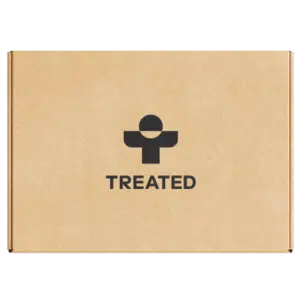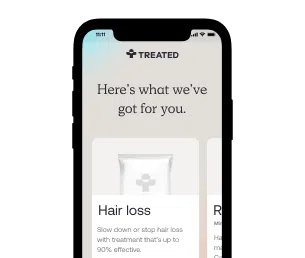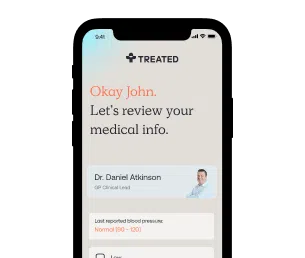Effective prevention for the symptoms of asthma.


Kelhale is a preventative inhaler, meaning it helps with swelling and irritation in the airways to tackle asthma at the source. Using it daily can control your symptoms and prevent asthma attacks, letting you breathe more freely.
At Treated, our experts are dedicated to helping you choose the right asthma treatment for you. We’ll recommend the treatments that suit you best. When you order Kelhale online with us, our clinicians will check in with you to ensure the treatment is going well, and answer any questions you might have.
Kelhale is a preventer inhaler, containing the corticosteroid beclomethasone. Corticosteroids help reduce your risk of an asthma attack and prevent you experiencing symptoms over the long-term. Taking your Kelhale inhaler daily will help you keep your condition controlled and manageable.
Kelhale is a preventative treatment you’ll take daily. It’ll work to reduce the frequency and severity of your symptoms in the long term. Normally, you’ll use it alongside a separate reliever (or rescue) inhaler. Reliever inhalers are used on-demand to relax your airways and let air pass through more easily, treating symptoms as they occur. Speak to your clinician if you don’t have a rescue inhaler, but think you might need one.
Kelhale’s active ingredient, the corticosteroid beclomethasone, controls your asthma by suppressing the inflammation of your airways. It does this by inhibiting the actions of inflammatory cells, which opens the airways in your lungs and prevents asthma symptoms.
Kelhale will not provide immediate relief if you’re breathless, wheezing, or having an asthma attack. You should take a separate rescue inhaler if you experience these symptoms. Rescue inhalers contain a medicine that will relax your airways, making it easier to breathe. Speak to your clinician if you’re taking Kelhale and don’t have a separate rescue inhaler, but think you need one.
Kelhale comes in two doses. The dosage you’re prescribed and how often you take it will depend on the severity of your condition and your level of control over it.
The lower dose is Kelhale 50 micrograms, and the larger is Kelhale 100 micrograms. If your asthma is mild, you’ll likely be instructed to take 100-200mcg a day over two doses. For moderate cases, 200 to 400 mcg over two doses per day is typical. If your asthma is severe, you’ll usually need to take 400-800mcg over two doses every day. You should only ever use your inhaler as you’re instructed to by your clinician.
A new Kelhale inhaler has 200 doses, shown by the dose indicator on the back of the inhaler. This will tick down every 20 sprays – when it shows 40 doses left your inhaler needs replacing.

How we source info.
When we present you with stats, data, opinion or a consensus, we’ll tell you where this came from. And we’ll only present data as clinically reliable if it’s come from a reputable source, such as a state or government-funded health body, a peer-reviewed medical journal, or a recognised analytics or data body. Read more in our editorial policy.
Kelhale comes in a metered dose inhaler, or an MDI. This means the medicine is held in a pressurised canister, and when sprayed releases a measured dose of treatment. If it’s the first time you’re using your inhaler, or if it’s been a couple of weeks since you last used it, you should check to make sure it’s still working properly.
Once you’re sure your inhaler is working properly, follow these steps to get the most from your treatment:
As Kelhale is a preventer inhaler, it’ll usually take three to seven days before you start to notice its effects. Once it starts working, you should notice a reduction in symptoms like wheezing and shortness of breath, as it suppresses any inflammation in your airways. If you don’t notice any improvement after a week, you should get in touch with your clinician. Your treatment might need a little tweaking.
Kelhale will not give you any relief from an asthma attack or symptoms in the moment, and you shouldn’t take it if you’re experiencing breathlessness. If you’re experiencing sudden symptoms, you’ll need a separate reliever or combination inhaler, which contains a medicine known as a bronchodilator that opens up your airways.
You should make sure to only take Kelhale as you’re instructed to by your clinician. If you forget to take a dose, it’s no big deal – just take it as soon as you remember. If you only remember when you’re close to taking your next dose, simply skip the one you missed and continue as normal from the upcoming one. As much as you might be tempted, never take two doses at once to make up for a missed dose – you won’t get any extra benefit and it’ll just increase your risk of getting side effects.
Accidentally taking too much Kelhale at once is unlikely to cause any immediate effects, especially if you only do it once. If you take too much over a prolonged period of time, you could suffer from adrenal suppression. This is where your body’s adrenal glands don’t produce enough hormones, and can cause weakness, fatigue, nausea, vomiting, and headaches. This is still much less likely to occur with inhaled corticosteroids than with oral corticosteroid tablets.

How we source info.
When we present you with stats, data, opinion or a consensus, we’ll tell you where this came from. And we’ll only present data as clinically reliable if it’s come from a reputable source, such as a state or government-funded health body, a peer-reviewed medical journal, or a recognised analytics or data body. Read more in our editorial policy.
Have something specific you want to know? Search our info below, or ask our experts a question if you can’t find what you’re looking for.

Registered with GMC (No. 4624794)
Meet Daniel
Registered with GPhC (No. 2202465)
Meet Sanjeda
Registered with GPhC (No. 2070724)
Meet CraigDelivery, consultation, treatment. It’s all included in the price.
| Quantity | Starting from |
|---|---|
| 200 Dose | £33.95 |
| 400 Dose | £55.95 Save £11.95 |
| Quantity | Starting from |
|---|---|
| 200 Dose | £33.95 |
| 400 Dose | £55.95 Save £11.95 |
| 600 Dose | £73.95 Save £27.90 |
| Quantity | Starting from |
|---|---|
| 200 Doses | £37.95 |
| 400 Doses | £59.95 Save £15.95 |
| Quantity | Starting from |
|---|---|
| 200 Doses | £51.95 |
| 400 Doses | £86.95 Save £16.95 |
| Quantity | Starting from |
|---|---|
| 200 Doses | £51.95 |
| 400 Doses | £86.95 Save £16.95 |
| Quantity | Starting from |
|---|---|
| 120 Dose | £74.95 |
| 240 Dose | £132.95 Save £16.95 |
| 360 Dose | £201.95 Save £22.90 |
| Quantity | Starting from |
|---|---|
| 60 Dose | £74.95 |
| 120 Dose | £132.95 Save £16.95 |
| Quantity | Starting from |
|---|---|
| 120 Dose | £88.95 |
| 240 Dose | £153.95 Save £23.95 |
| 360 Dose | £203.95 Save £62.90 |
| Quantity | Starting from |
|---|---|
| 120 Dose | £88.95 |
| 240 Dose | £153.95 Save £23.95 |
| 360 Dose | £203.95 Save £62.90 |
| Quantity | Starting from |
|---|---|
| 28 Tablet | £25.95 |
| 56 Tablet | £39.95 Save £11.95 |
| 84 Tablet | £52.95 Save £24.90 |
| Quantity | Starting from |
|---|---|
| 30 Dose(s) | £63.95 |
| 60 Dose(s) | £113.95 Save £13.95 |
| 90 Dose(s) | £153.95 Save £37.90 |
| Quantity | Starting from |
|---|---|
| 30 Dose(s) | £78.95 |
| 60 Dose(s) | £135.95 Save £21.95 |
| 90 Dose(s) | £188.95 Save £47.90 |
| Quantity | Starting from |
|---|---|
| 200 Dose | £24.95 |
| 400 Dose | £39.95 Save £9.95 |
| 600 Dose | £51.95 Save £22.90 |
| Quantity | Starting from |
|---|---|
| 1 Pack | £35.95 |
| 2 Pack | £58.95 Save £12.95 |
| 3 Pack | £74.95 Save £32.90 |
| Quantity | Starting from |
|---|---|
| 1 Pack | £65.95 |
| 2 Pack | £113.95 Save £17.95 |
| 3 Pack | £155.95 Save £41.90 |
| Quantity | Starting from |
|---|---|
| 1 Pack | £76.95 |
| 2 Pack | £134.95 Save £18.95 |
| 3 Pack | £187.95 Save £42.90 |
| Quantity | Starting from |
|---|---|
| 1 Pack | £53.95 |
| 2 Pack | £88.95 Save £18.95 |
| 3 Pack | £119.95 Save £41.90 |
| Quantity | Starting from |
|---|---|
| 120 Dose | £47.95 |
| 240 Dose | £79.95 Save £15.95 |
| 360 Dose | £107.95 Save £35.90 |
| Quantity | Starting from |
|---|---|
| 120 Dose | £72.95 |
| 240 Dose | £129.95 Save £15.95 |
| 360 Dose | £171.95 Save £46.90 |
| Quantity | Starting from |
|---|---|
| 1 Pack | £72.95 |
| 2 Pack | £129.95 Save £15.95 |
| 3 Pack | £171.95 Save £46.90 |
| Quantity | Starting from |
|---|---|
| 1 Pack | £72.95 |
| 2 Pack | £129.95 Save £15.95 |
| 3 Pack | £171.95 Save £46.90 |
| Quantity | Starting from |
|---|---|
| 1 Pack | £72.95 |
| 2 Pack | £129.95 Save £15.95 |
| 3 Pack | £171.95 Save £46.90 |
| Quantity | Starting from |
|---|---|
| 1 Inhalers | £25.95 |
| 2 Inhalers | £38.95 Save £12.95 |
| 3 Inhalers | £49.95 Save £27.90 |
| Quantity | Starting from |
|---|---|
| 1 Inhalers | £29.95 |
| 2 Inhalers | £49.95 Save £9.95 |
| 3 Inhalers | £64.95 Save £24.90 |
We know health, but you know you.
Our experts tell you what’s safe, but you decide what’s best.
Answer a few questions and tell us about yourself. Get tailored advice from our clinicians so you can choose better.

Choose your treatment and how often you have it delivered.

We know things change. It’s the nature of life. We’ll check in regularly to make sure your treatment is still right for you.
Pause. Change. Skip. Start again. Any time you like.
Always arrives on time and I’m kept informed of progress.
I have had it previously from my G.P so It worked as expected, extremely well. My problem is an accessing my G.P practice, they put ED well down their list of priorities. I found your service excellent, quick and efficient. I fully intend to continue using it
Shipping is speedy and the product is amazing.
Fast, slick service. Very easy to amend subscription when required.
All good.
Great service
Really helped me
Trusted service and great service - next day delivery and I can rely on them to send regularly.
Ordering was straight forward, tablets delivered promptly and well packaged, and instructions were clear, thanks.
100% recomended.Great service
Excellent service
Excellent delivery. Can’t fault.
Quick and efficient service, delivered discreetly the next day. Thank you.
Effective
Great service, no wait time
Great
Quick assessing for medicine suitability. Quick delivery and good communication throughout.
Straightforward and quick service!
Good however communication could sometimes be better
Easy and good procedure to get treatment
Excellent product
Excellent service!!! Ordered what I needed sent a picture of my prescription and the parcel arrived the next day!!! Will definitely order again and have recommended to others!!!
Fast shipping
Very quick service all round
So quick and simple. Recommend
Great
Very convenient hassle free service.
Easy to use good communication and fast shipping
Great service
Efficient no issues re delivery
Fabulous service
Brilliant service. Not a bad word to say!
It was fast, professional and it's the right med for what I selected in there.
This review requires content. Oh well..
Great service, quite effortless.
Top notch
Brill service
N/a
Excellent service quick and easy to use
Fast and exact order
Superb service and quick delivery 10/10
Excellent service
Thank you for fast delivery
Shipping is extremely quick and satisfiying
Good stuff
Good service
Great fast delivery
Asthma: Here are some other options.
A daily preventer inhaler that controls asthma symptoms. Available in 3 different strengths.
Keep your asthma or COPD under control with combined long-term relief and prevention.
A combination inhaler for asthma maintenance. Sometimes used as a reliever.
One a day preventative asthma tablets. Generic version of Singulair.
An easy-to-use preventer inhaler for long term asthma symptoms.
Blue, CFC free inhaler that acts fast to relieve asthma symptoms.
Long acting bronchodilator for asthma. It opens up the airways and tackles inflammation.
A preventer inhaler usually taken on a daily basis to keep your asthma well managed.
Quickly relieves asthma symptoms by relaxing your airways to help you breathe more easily.
We're making healthcare more about you. Sign up to our newsletter for personalised health articles that make a difference.
Disclaimer: The information provided on this page is not a substitute for professional medical advice, diagnosis, or treatment. If you have any questions or concerns about your health, please talk to a doctor.
‘Inhaled Corticosteroids.’ Pharmaceuticals, vol. 3, no. 3. (Accessed 29/09/2022)
‘Adrenal suppression: A practical guide to the screening and management of this under-recognised complication of inhaled corticosteroid therapy.’ Allergy, Asthma & Clinical Immunology, vol. 7, no. 13. (Accessed 30/09/2022)
‘Safety and efficacy of beclomethasone dipropionate delivered by breath-actuated or metered dose inhaler for persistent asthma.’ Allergy Asthma Proc., vol. 37, no. 5. pp. 359-369. (Accessed 30/09/2022).
Package leaflet - Information for the user Kelhale 50 micrograms per actuation pressurised inhalation solution. Kelhale 100 micrograms per actuation inhalation solution. (Accessed 29/09/2022).
‘Comparison of the Effects of Beclomethasone Dipropionate and Budesonide in the Treatment of Children with Mild, Persistent Asthma.’ Cureus, vol. 13, no. 19. (Accessed 30/09/2022).
Kelhale 50 micrograms per actuation pressurised inhalation solution. (Accessed 30/09/2022).
We couldn't find what you're looking for.
Here's everything we treat. Or, if you're looking for something we don't have yet, you can suggest something.
If there’s a particular treatment or condition you’re looking for, tell us and we’ll look into it for you.
Submit your question here, or tell us if you’ve found an issue on our site.
We’ll get back to you very soon. We aim to respond to all queries in one working day.
You’re signed up to our newsletter. Keep an eye on your inbox for our latest update.
By clicking 'Subscribe now' you're agreeing to our Privacy Policy.
We’ve sent you an email asking you to confirm your email address.